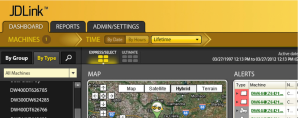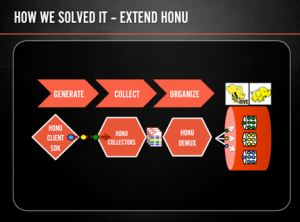
Monsanto is more infamous for growing its genetically modified corn than its software, but a series of corporate acquisitions and a new emphasis on IT solutions has made it a firm that acts more like an innovative IT vendor than an agribusiness giant, and is definitely worth watching. They are a good example of how agribusiness companies are getting interested in Big Data, as we wrote about last year
At a presentation at a downtown St. Louis tech incubator entitled, “The Role of IT in Modern Agriculture,” Jim McCarter reviewed where the agribusiness giant is going with its IT efforts to an audience of entrepreneurs and civic leaders. McCarter is the Entrepreneur in Residence for Monsanto and has worked there less than two years. Before he came there, he ran his own biotech startup where he developed pest control molecules. He is also is a genetics professor at Washington University.
One of their goals is to produce crops that can double their yields by 2030. This focus on productivity and sustainable agriculture pervades the company. “IT is becoming increasingly central to what we do, and we are integrating IT into all aspects of our business now,” he said.
“Monsanto has become a data-driven culture.” The proof is how much data they now keep track of. (See the chart below.) One issue is that Monsanto is involved in efforts that generate huge amounts of bits: there are its genomic efforts, which have gotten public attention to be sure. But there are also phenotypes of millions of plant DNA structures that describe the various biological properties of each plant, and remote sensing photographic imagery of crop fields. All told they have several tens of petabytes that need storage and analysis, and it is doubling about every 16 months too. As a result, Monsanto has become a big user of Hadoop and H Base and other Big Data tools to manage all this data.
The company is headquartered in St. Louis with more than 21,000 employees in 500 different locations around the globe. About 5,000 of them are engaged in basic research and development, and the company is investing about $1.4 billion in R&D each year. While isn’t at the levels of an IBM or Microsoft, it is an impressive figure for a company that just a few years ago didn’t have many IT-related employees.
To give you some perspective, a quick search of job openings on Monsanto’s website this week shows 24 positions involving Big Data, including one for an IT Commercial Delivery Lead for Global Infrastructure that could have been lifted right from the pages of a bank or insurance company’s career pages. Another example is two current openings on Dice for Hadoop developers.
This isn’t the only iPad use case for Monsanto. They have deployed more than 1,500 of them to their field support staff to keep them in front of growers and spend less time on administrative work. The company also has several other IT-based initiatives such as FarmCare, to use mobile phone alerts about real-time weather threats to farmers, and North Star, a global supply chain transportation management system that has saved millions of dollars in overhead costs.
Monsanto isn’t trying to go at this alone. There have other IT collaborations going on, and are partnering up in specialized areas such as remote imaging, high performance computing and computational biology. This tracks with what other large multinational firms are doing as they capture more data and try to use it as part of their basic business decision-making.
Another way the company has grown over the last several years is through acquisitions. Last year they purchased Precision Planting. That company has been applying software to farming techniques and will form the first of Monsanto’s efforts in what it calls Integrated Farming Systems and its FieldScripts software. (See descriptive illustration below.) It is presently in beta and runs on an iPad that connects to the tractor planter controls. “Just like Amazon has its recommendation engine for what book to buy, we will have our recommendations of what and how a grower should plant a particular crop,” said McCarter. “All fields aren’t uniform and shouldn’t be planted uniformly either,” he said. The software will look at two different crops and different planting densities as a farmer is sowing his crop, taking into account geospatial data and other analytics about crop performance. “Farmers are very data driven,” said Erich Hochmuth, the data analysis architecture lead for Monsanto. “And when they hear that they can improve their crop yields by anywhere from five to ten bushels per acre, that gets their attention. That can add up, and can be a big motivation for farmers to adopt our technology.”
 The use of Big Data is growing rapidly as companies seek to use its power to help improve business efficiency and look for new business opportunities. In this presentation for the local chapter of the Data Warehousing Institute, I will discuss how big data is being applied across a variety of industries, including even farm tractor maker John Deere, illustrated above.
The use of Big Data is growing rapidly as companies seek to use its power to help improve business efficiency and look for new business opportunities. In this presentation for the local chapter of the Data Warehousing Institute, I will discuss how big data is being applied across a variety of industries, including even farm tractor maker John Deere, illustrated above.

 The old saying that opposites attract now has some mathematical validity, at least according to a new research
The old saying that opposites attract now has some mathematical validity, at least according to a new research 

